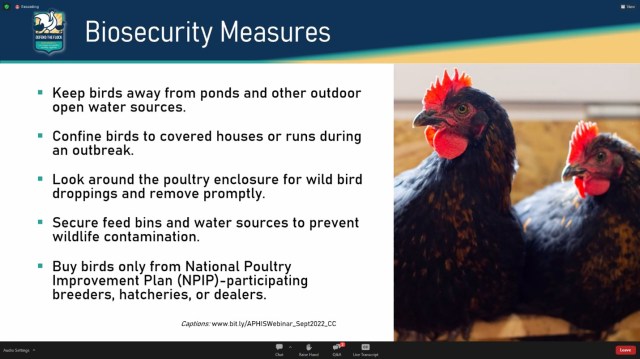Home \ Knowledge Hub \ Articles \ Biosecurity Lessons from ‘Navigating Avian Influenza: from Prevention to Recovery’ Webinar


08 Nov 2022
Biosecurity Lessons from ‘Navigating Avian Influenza: from Prevention to Recovery’ Webinar
SHARE

RACHEL HERSCHMAN
Intern, International Veterinary Health MSD Animal Health
High pathogenic avian influenza (HPAI) has affected more than 45 million birds and over 500 flocks this year in the United States alone. And unlike the 2015 HPAI Outbreak, cases this year have continued throughout the summer and are still being confirmed well into the fall. This virus is a contributing factor to the US’s skyrocketing food prices, as one HPAI-positive bird in a flock triggers the depopulation of the whole flock. There is no treatment nor cure, and the mortality rate in chickens is more than 95%. Infected birds often suffer sudden death with few to little clinical signs.
This past September, the USDA’s Animal and Plant Health Inspection Service (APHIS) hosted a webinar presenting materials from their Defend the Flock education program. This program provides practical and affordable mitigation measures that commercial and backyard operations alike can adopt to stop the spread of HPAI. Dr. Julie Gauthier from APHIS spoke about how wild birds are the clear source of this year’s outbreaks, accounting for 85% of cases. This is why keeping wild birds away from poultry flocks is one of the most important aspects of flock biosecurity.

The National Poultry Improvement Plan (NPIP) works to prevent flocks from being infected by new additions of animals that might harbor a disease, such as chicks. Several avian diseases, including avian influenza, are tested for and monitored in flocks that participate in NPIP and the operation’s disease status is publicly available. In the past, this has worked spectacularly well to control other deadly avian diseases such as Pullorum Disease and Fowl Typhoid.
HPAI can spread very easily from flock-to-flock and so it was also highly recommended by Dr. Gauthier for those who have a poultry flock to disinfect equipment regularly, wash hands frequently, to never share tools, and to keep a dedicated pair of shoes that never leave the farm. How visitors are managed is also a major consideration and can entail separate visitor parking in an area that is furthest away from where birds are kept as well as recording visitors’ prior 14-day exposure history (ex. visits to other poultry farms). Most farms require people to have no contact with poultry within 72 hours prior to visiting.
A point stressed throughout the webinar was the need for quick reporting of sick birds to the appropriate personnel so that testing services can be deployed immediately. Some examples listed were veterinarians, local extension offices, and the state’s Board of Animal Health. The USDA also has a toll-free number (1-866-536-7593) that can give a local contact for reporting. The only way to diagnose avian influenza is through specialized lab testing of samples taken from birds.
Cathryn Anderson from Pineland Farms, a 5,000-acre diversified farm and agricultural education center in Maine, was another guest on the webinar. She spoke of her experience with an HPAI scare in the spring of this year when 20 chickens on their farm suddenly died. Immediately, the farm put their HPAI emergency response plan into action and took measures such as separating poultry-related activities from the rest of the farm in order to contain the possible outbreak. A lab-confirmed positive case would have necessitated depopulating the rest of their 500 birds within 48 hours of the results. Thankfully, the lab results were HPAI-negative.
Resources:
USDA HPAI 2022 Confirmed Detections map
USDA Defend the Flock – Resource Center
RACHEL HERSCHMAN
Intern, International Veterinary Health MSD Animal Health

